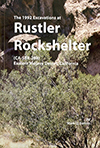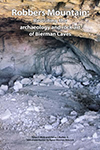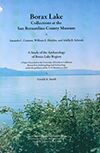The Anthropology Division is responsible for the curation, management, conservation, and study of the museum's anthropology collections. These collections include ethnographic collection, the archaeological assemblages and site records, special rock art slides, and photographs. The curator is also in charge of the Archaeological Information Center, and the research library. For more information, contact Curator of Anthropology Adella Schroth at (909) 798-8622 or e-mail aschroth@sbcm.sbcounty.gov.
Archaeology
The archaeological collections consist of artifactual and ecofactual material from historical and prehistoric archaeological sites. The majority of the prehistoric artifacts are lithic, although some items made from vegetable or animal products are present. The historical material consists primarily of metal and glass items, although a few wood items are also present.
The archaeological collections include assemblages from research conducted by archaeological avocational groups, professional archaeologists conducting private research, cultural resource management (CRM) contracts, and from donations. Our curation facility is accepted by the federal government as an official repository for site assemblages removed from federal lands. Additional assemblages are the result of valid professional research completed with appropriate permits.
The Hall of History contains artifacts from Newberry Cave, the Calico Site, bifaces from several sites in the western United States, an Archaic display, a science and archaeology display, and a lithic technology display.
- Pre-projectile Period: before 18,000 BC (before 20,000 years ago)
- Late Pleistocene Period: 18,000 to 8,000 BC (20,000 to 10,000 years ago)
- Archaic Period: 8,000 to 2,000 BC (10,000 to 4,000 years ago)
- Intermediate Period: 2,000 BC to AD 500 (4,000 to 1,500 years ago)
- Late Period: AD500 to AD 1700 (1,500 to 300 years ago)
- Historic Period: AD 1700 to present (300 years ago to the present)
To learn more about an ongoing archaeological project, please visit the Friends of the Calico Early Man website.
Archaeological Information Center (AIC)
The California Historic Research Information System (CHRIS) provides current archaeological historical, and historic architectural information for the entire state of California. Our office, called the Archaeological Information Center, is part of that system. It provides information for San Bernardino County to:
- qualified archaeologists and federal and state agencies
- Native Americans
- planning departments
- students
- landowners
- historians and historical societies
- historic architects and architectural historians
This sensitive information can only be made available to qualified individuals and agencies with appropriate identification for the protection of the resources. The information can be used for planning decisions, environmental decisions, surveys, excavations, and research.
The AIC gathers data and makes recommendations for cultural resource work based on existing federal and state law, and reviews the resulting reports for accuracy. The AIC also instructs students, individuals, and archaeological and historical societies on how to fill out and submit site records, National Register forms, Landmark Points of Interest forms, and Historic Structure forms; how to map sites; and how to read topographic maps.
For more information, please contact Robin Laska at (909) 307-2669 ext. 255 / TDD/TTY: (909) 792-1462.Ethnobotany
The Doris Hoover Bowers ethnobotany collection and library is housed in the museum's anthropology division. The collection was donated by Bowers in conjunction with the Archaeological Survey Association of Southern California (ASA).
In the 1960s and 1970s, Doris collected native seeds and plants from sites in southern California for the ASA to use when they conducted archaeological investigations. The collection has been maintained and supplemented over the years. Archaeologists can use it to help identify plants found in and around archaeological sites. This information helps archaeologists determine what activities had been conducted at a site.
The seeds and plants have been meticulously cross-referenced in a number of different ways to promote easy location of the information. Plants and seeds have been identified by common and scientific names. The collection also contains a catalog of Native American and pioneer uses of these plants and an extensive bibliography for each plant.
Archaeologists are invited to visit the Doris Hoover Bowers Ethnobotany Lab by appointment to use this valuable research tool. To make an appointment, contact Adella Schroth, curator of anthropology, (909) 307-2669 ext. 266 / TDD/TTY: (909) 792-1462.
Ethnography
The ethnographic collections consist of items associated with extant or recently extinct populations from around the world. The items are made from animal, vegetable, and/or mineral products and include textiles, clothing, baskets, wooden containers, ceramics (pots and ollas), musical instruments from various countries, and weapons.
The museum's Hall of History contains exhibits showing the material cultures of Native Americans from San Bernardino County and changing exhibits of ethnographic objects from around the world.
Photographs and Slides
Photographs and 35 mm slides of the Calico Site and of rock art sites (petrolyphs, pictographs, rock alignments, rock cairns, and rock walls). Notable collections include:
- the Wilson Turner "Black Canyon" slide collection
- the Arda Haenszel collection of rock art slides and photographs
- the Ruth DeEtte Simpson collection of slides and photographs from the Calico Early Man Site (1974 to 2000)
Available for research by appointment.
Publications

Rustler Rockshelter - The 1992 Excavations at Rustler Rockshelter
(CA-SBR-288), Eastern Mojave Desert, California.
Mark Q. Sutton. SBCMA Quarterly 52(4) 2005.





